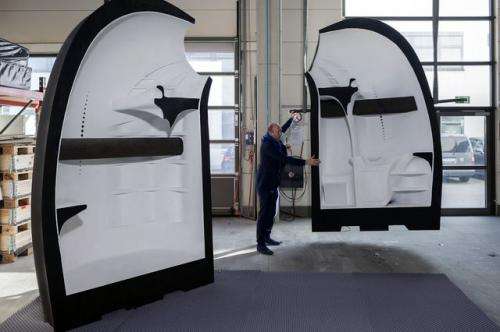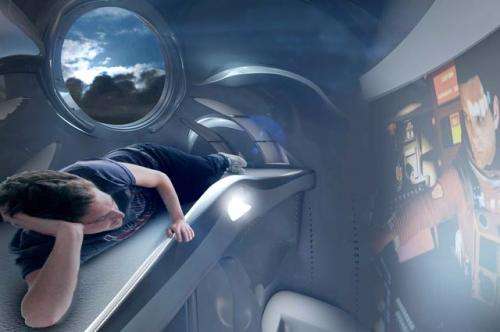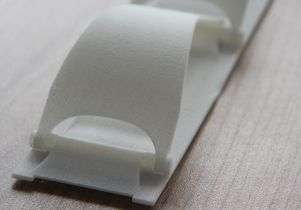Architecture and urban design students helped create a fully functional microhouse built using 3-D printing technology

(Phys.org) —A bed. A kitchen. A place for lounging and watching television. Full bathroom. Storage space. Those are typical minimum requirements for a person's apartment. Now imagine all of that packed into fewer than 50 square feet in a portable structure that you can "build" in one day.
That was what the third-year master of architecture students in UCLA's 3M futureLAB were challenged to create in just 10 weeks this past academic year. Thanks to 3-D printing technology, a prototype of the microhome of the future stands today.
With a base measuring roughly 7 feet wide, 7 feet long and standing 11 feet high, the four-ton dark gray structure, which was designed as two halves of an enclosed shell, it was when it was printed the largest residence ever created with a 3-D printer. And although it took marathon workdays for the team to design, the actual printing of the microhome took just a couple of days.
"Three-dimensional printing changes the paradigm of architecture," said Julie Mithun, who recently graduated from the Master of Architecture I program at UCLA. Mithun was one of six architecture and urban design students from UCLA and nine engineering students from the University of Huddersfield and from the Technical University / Hochschule München in Munich, Germany—who participated in the Munich-based 3M futureLAB, which runs every fall quarter. The other UCLA students were Sasha Geisler, Stephanie Odenheimer, Huwayda Fakhry and Tas Oszkay.
The 3M futureLAB, which was created by UCLA architecture and urban design visiting professor Peter Ebner and is sponsored by 3M, began in 2009. Ebner wanted to re-think architecture education and create a platform that challenged students to work at the intersection of architecture, art, technology and society by not only designing buildings but also engaging with engineers, artists, manufacturers, writers and designers throughout Germany and nearby German-speaking countries.
"If you want to develop something new you have to work with different fields of engineering, like aerospace engineering, mechanical engineering, chemistry … ," said Ebner, who chose to create futureLAB at UCLA because he studied architecture here as a student in 1994-5. In past years, futureLAB students have worked on projects related to urban planning and designed houses and offices of the future.
Ebner chose 3-D printing and portable microhomes for this year's project because it fits the mission of 3M futureLAB—using technology to develop solutions to social problems, like alleviating overcrowding in urban areas that have insufficient affordable housing, while using fewer materials. Currently, an estimated 50 percent of young adults across the world live by themselves in cities, and that percentage is expected to grow. Smaller, cheaper-to-build homes that people could literally pick up and pack into a storage container and move as they change jobs have an appeal.
To build a fully equipped home that would fit inside a standard shipping container (portability was a requirement), the students had to think of everything as multipurpose or capable of being hidden when not in use.
"The bed had to be above the bathroom; the sink had to turn into a soaking tub," said Andresa Pardini Maia, who also just finished the the M.Arch. I program. "The table had to flip up from the wall. We had to make things multifunctional."
Storage is available under the floor. The toilet can fold into the wall. Just under the sleeping deck is a tiny projector that shows television or movies onto the opposite wall.

Ebner asked the students to take advantage of the unique advantages of 3-D printing. "We said, 'Let's start from the beginning to think about what 3-D printing allows us to integrate in a way that's not possible in traditional construction?'"
Integration in 3-D printing is much more than function; by definition, it's also form. The entire house was created using a special sand. During the printing process, the printer, owned by project partner Voxeljet, laid down ultrathin layer upon layer to produce the finished house, almost like reverse sculpting. After the machine prints all the layers, the house was excavated from the loose sand in the print bed, using brushes, compressed air and vacuums.
"The reason 3-D printing is interesting is because we try to reduce material used as much as possible," Mithun said.
Instead of making a wall out of a large assembly of parts comprised of layers of dry wall, insulation, air spaces and possibly pipes for water or heating/ventilation—much of this made out of different materials—the wall is printed in one piece out of one material.
To build a strong wall out of a material that would retain heat, the students modeled the interior of the walls to resemble the internal structure of bones, which are porous. Those capillary-like holes running through the walls assist in heating and cooling. Once the house was printed, a special sand/glue nano-material which is used for molding was infused into the capillaries to reinforce the structure.
The students also mimicked the biology of the natural world to create an efficient water recovery system. To capture rainwater for use in the bathroom, the students combined the curves of seashells and the grooves in the exterior of a cactus.
"What became interesting in the design process was not just putting all these functions together, but because we had to use one material for everything, we had to change the design of really simple elements," Mithun said.
For example, to make a soft "mattress" out of the same sand that composed the hard walls Maia designed a system of springs, each resembling the curved head of a spoon, that were just less than an inch long and with alternating thicknesses of 1-millimeter and 1.5-millimeters. The thinness of the springs gave them flexibility.
Maia, Mithun and Ebner said everyone was worried about finishing by the end of the quarter. Even though the class was scheduled to meet for eight hours every weekday, it was a 24/7 effort to finish, they said.

Even when the two halves were printed, the students still wondered whether it would hold together. Though they'd printed models at 1/10 and 1/3 scale, they hadn't yet printed one at full size.
"We were afraid that when they actually rotated the halves upright, it was going to somehow break," Maia said. The four-ton structure was designed to be printed using a much lighter weight plastic, but they had to use a heavier sand for the prototype.
Ultimately, they were able to lift the halves and show off their microhouse. Unfortunately, despite its portability via shipping container, it would have cost too much to ship it across the ocean to UCLA so it still resides in Germany.
Ebner contends that, since the 1920s when the introduction of structural steel and reinforced concrete redrew skylines with skyscrapers, architecture has stagnated technologically compared to other industries. Ebner cited a 1927 photo of the Double House in Weissenhofsiedlung by Le Corbusier, which showed a car and a house.
"If you look at the car, it looks old-fashioned [compared] to the house," Ebner said, "but now a lot of architects still design similar houses, and now the houses look old and the cars in front of the new houses look advanced. I want to correct this."
Three-D printing is revolutionizing architecture in two ways, Ebner said. First, 3-D printing's single-step production process could eliminate the "problems of the construction site" when individual parts are found broken, missing, incorrectly sized or improperly assembled. Secondly, 3-D printing could reduce the raw materials needed by half or more.
"In four or five years a lot of houses on the market will be 3-D printed," Ebner said. "I'm sure."
Provided by University of California, Los Angeles





















